This article was co-authored by Ray Spragley, DVM. Dr. Ray Spragley is a Doctor of Veterinary Medicine and the Owner/Founder of Zen Dog Veterinary Care PLLC in New York. With experience in multiple institutions and private practices, Dr. Spragley’s specializations and interests include non-surgical management of cranial cruciate ligament tears, Intervertebral Disk Disease(IVDD), and pain management in osteoarthritis. Dr. Spragley holds a BS in Biology from SUNY Albany and has a Doctor of Veterinary Medicine degree (DVM) from Ross University School of Veterinary Medicine. He is also a Certified Canine Rehabilitation Therapist (CCRT) through the Canine Rehab Institute as well as a Certified Veterinary Acupuncturist (CVA) through Chi University.
There are 8 references cited in this article, which can be found at the bottom of the page.
This article has been viewed 49,168 times.
Most people don’t consider that their dog can get skin cancer. The truth is that skin cancer is frequently diagnosed in dogs. There are three main types of skin cancer in dogs, all of which can be life threatening. Whichever type your dog has, early detection and diagnosis are key to increasing its chances of recovery.
Steps
Detecting Skin Cancer Early
-
1Screen your dog routinely for signs of skin cancer. As with all illnesses, detecting the symptoms early gives the best chance for a successful outcome. Make weekly full body examinations a routine. Run your hands over every inch of your dog to feel for any lumps or bumps.[1] [2]
- Your dog will probably love this attention and may think it’s a massage.
- Different types of skin cancer look different. With one common type, Cutaneous Squamous Cell Carcinoma, a bleeding sore appears that will not heal with creams or antibiotics. These sores are generally red and may look like an ulcer.
-
2Monitor any lumps for changes in size or color. If you find a lump or bump on your dog’s skin carefully check over the rest of the dog’s body for further lumps. Use a centimeter graded ruler to measure the widest part of the lump and write the measurement down along with color and any other signs associated with the lump. Check the lump daily to see if it goes away.Advertisement
-
3Contact your veterinarian. If the lump you have been monitoring doesn’t go away within a few days or grows in size, see your veterinarian.[3] In addition, if you notice any of these symptoms call your veterinarian right away:[4]
- Rapid increase in size
- Swelling of surrounding skin
- Redness of lump or skin around it
- Ulceration
- Drainage of fluid
- Lump is itchy when touched or dog itches it
-
4Be aware that there are growths that are not malignant skin cancer. Most lumps you find on dogs are just fatty tumors, not cancer.[5] Remember that there are things that look like skin cancer but in fact aren't or aren't malignant. This is why it is so important to stay calm and get a professional opinion before suspecting the worst.
- In fact, some of the most common types of skin cancer in dogs, such as Squamous cell carcinoma, do require surgical removal but do not usually require chemotherapy or radiation afterword.[6]
Diagnosing and Treating Skin Cancer
-
1Get a medical diagnosis. While the three main skin cancers of dogs all have their own characteristics, none of them can be definitively diagnosed from merely looking at them. A proper diagnosis is based upon close examination of the cells in a lump. In order to do this, a veterinarian will insert a thin needle into the suspicious lump, draw back on the needle to fill the needle with cells, and then examine those cells under a microscope.
- Sometimes a larger piece of the tumor (biopsy) or the entire tumor will need to be examined in order to find a correct diagnosis.[7]
-
2Get the skin cancer treated. Surgical removal is the most recommended, and in many cases curative, treatment. It is best to have the surgery done quickly after diagnosis in order to have the best possible outcome.
-
3Follow directions for follow-up care. More aggressive tumors may need to be followed up with radiation or chemotherapy treatment. These follow up treatments are needed in order to cure the cancer or, in some cases, to slow the cancer's growth and to give the dog a measure of relief from the on-going cancer progression.
- Each case is different and only your veterinarian can help you to decide the best course of action.
Learning About the Types of Skin Cancer in Dogs
-
1Learn about mast cell tumors. Mast cell tumors are the most common skin tumors in dogs. Almost one quarter of all skin tumors are this type.[8] On the skin, mast cell tumors generally appear as raised solid raspberry like bumps but their appearance can vary. They are generally single lesions but in some cases there can be multiple lumps. Some of them can have ulcerated (raw appearing) skin.
- Many times mast cell tumors itch and the surrounding skin is reddened.
- Mast cells are blood cells that are part of the immune system and are produced in response to allergens and inflammation.[9]
- Why some mast cells develop into tumors is not understood but they are more likely in dogs from 8-10 years of age and in certain breeds (pugs, boxers, Boston terriers, and Rhodesian ridgebacks).[10]
-
2Understand malignant melanomas. Melanomas are tumors that arise from the pigmented cells in the skin. In dogs they are most common on the skin, toenails, and mouth. While the skin melanomas are usually benign (do not spread) the ones on the toes and mouth are usually aggressive, hard to treat, and frequently spread to other parts of the body.
- Melanomas occur more frequently on the head and front legs of older dogs.[11]
- Schnauzers and Doberman Pinchers have a high rate of this type of tumor.
- They are typically raised dark colored lumps. The ones in the mouth can interfere with eating, cause the dog to drool or bleed from the mouth and cause bad breath. Toenail melanomas can cause the toe to swell, the toenail to fall off, and make the dog limp.
- Occasionally melanomas are NOT dark colored and will be the same color as the skin surrounding them.
-
3Learn about squamous cell carcinoma. This type of skin cancer is less common in dogs than mast cell and melanoma tumors. In humans, it’s related to sun exposure but that isn’t really true in dogs, as their fur coats offer sun protection.
- Dogs with little hair or light colored dogs can get sun-induced skin cancer, but this isn’t very common. As like the other types of skin cancer it is more common in middle-aged to older dogs.[12]
- Squamous cell carcinomas can look like raised lumps with ulcerated skin.
Expert Q&A
-
QuestionWhat does skin cancer look like on dogs?
 Ray Spragley, DVMDr. Ray Spragley is a Doctor of Veterinary Medicine and the Owner/Founder of Zen Dog Veterinary Care PLLC in New York. With experience in multiple institutions and private practices, Dr. Spragley’s specializations and interests include non-surgical management of cranial cruciate ligament tears, Intervertebral Disk Disease(IVDD), and pain management in osteoarthritis. Dr. Spragley holds a BS in Biology from SUNY Albany and has a Doctor of Veterinary Medicine degree (DVM) from Ross University School of Veterinary Medicine. He is also a Certified Canine Rehabilitation Therapist (CCRT) through the Canine Rehab Institute as well as a Certified Veterinary Acupuncturist (CVA) through Chi University.
Ray Spragley, DVMDr. Ray Spragley is a Doctor of Veterinary Medicine and the Owner/Founder of Zen Dog Veterinary Care PLLC in New York. With experience in multiple institutions and private practices, Dr. Spragley’s specializations and interests include non-surgical management of cranial cruciate ligament tears, Intervertebral Disk Disease(IVDD), and pain management in osteoarthritis. Dr. Spragley holds a BS in Biology from SUNY Albany and has a Doctor of Veterinary Medicine degree (DVM) from Ross University School of Veterinary Medicine. He is also a Certified Canine Rehabilitation Therapist (CCRT) through the Canine Rehab Institute as well as a Certified Veterinary Acupuncturist (CVA) through Chi University.
Veterinarian Skin cancer may appear as bumps or lumps on your dog's skin. Make note of their size and appearance so you can point them out to your vet.
Skin cancer may appear as bumps or lumps on your dog's skin. Make note of their size and appearance so you can point them out to your vet.
Warnings
- Do not shave your dog in the summer. Hair helps to keep your dog’s skin hidden from sunlight.⧼thumbs_response⧽
References
- ↑ Ray Spragley, DVM. Veterinarian. Expert Interview. 31 March 2021.
- ↑ http://www.thedogdaily.com/health/illness/canine_skin_cancer/index.html#.VnIoJjYleRs
- ↑ Ray Spragley, DVM. Veterinarian. Expert Interview. 31 March 2021.
- ↑ http://pets.webmd.com/dogs/dog-lumps-bumps-skin
- ↑ http://pets.webmd.com/dogs/dog-lumps-bumps-skin
- ↑ http://pets.webmd.com/dogs/dogs-and-skin-cancer
- ↑ Ray Spragley, DVM. Veterinarian. Expert Interview. 31 March 2021.
- ↑ www.wearethecure.org/mast-cell-tumors
- ↑ http://www.vet.upenn.edu/docs/default-source/ryan/oncology-handouts/final-canine-mct.pdf?sfvrsn=4
- ↑ http://www.merckvetmanual.com/pethealth/dog_disorders_and_diseases/skin_disorders_of_dogs/tumors_of_the_skin_in_dogs.html
- ↑ http://www.merckvetmanual.com/pethealth/dog_disorders_and_diseases/skin_disorders_of_dogs/tumors_of_the_skin_in_dogs.html
- ↑ http://www.wearethecure.org/squamous-cell-carcinoma
About This Article
To detect skin cancer in dogs, routinely run your hands over your dog’s body, feeling for bumps or lumps. If you do find some raised areas, measure the lump, note the color, and monitor the area to see if it goes away. Most lumps are just fatty tumors that won’t harm your dog, but you’ll want to contact your veterinarian if the lump grows in size, becomes red, or drains fluid. Once skin cancer has been confirmed, your vet will typically recommend immediate surgical removal for the best chances of a full recovery. For more tips from our Veterinary co-author, including how to treat aggressive skin cancer in your dog, keep reading!


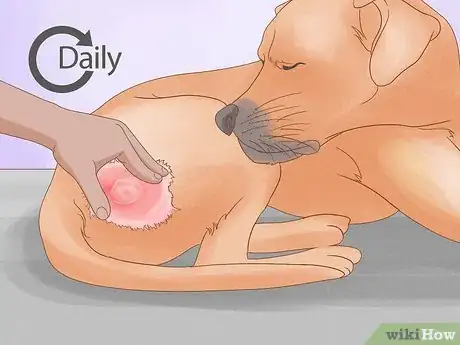


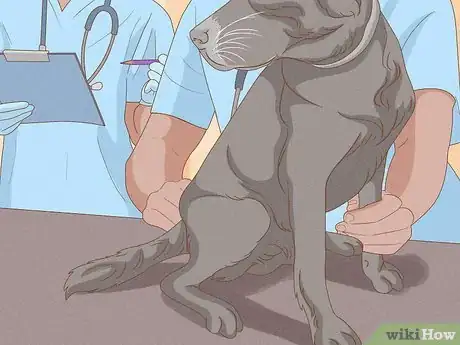

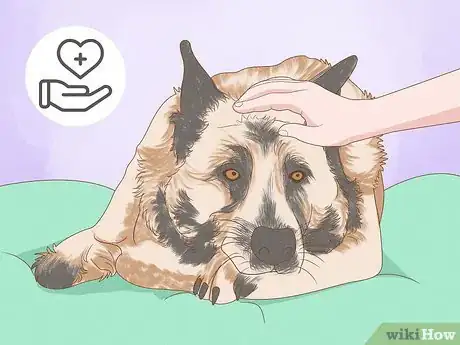

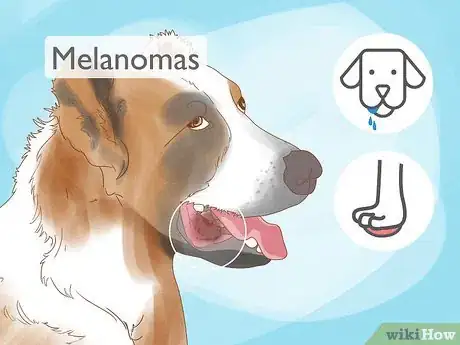
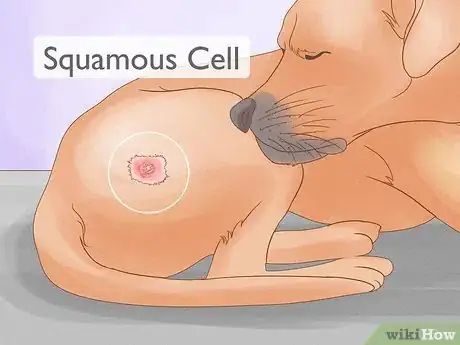




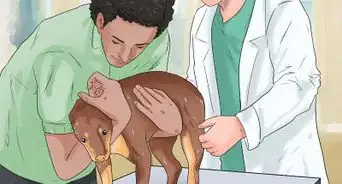







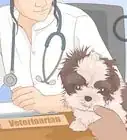







































Medical Disclaimer
The content of this article is not intended to be a substitute for professional medical advice, examination, diagnosis, or treatment. You should always contact your doctor or other qualified healthcare professional before starting, changing, or stopping any kind of health treatment.
Read More...